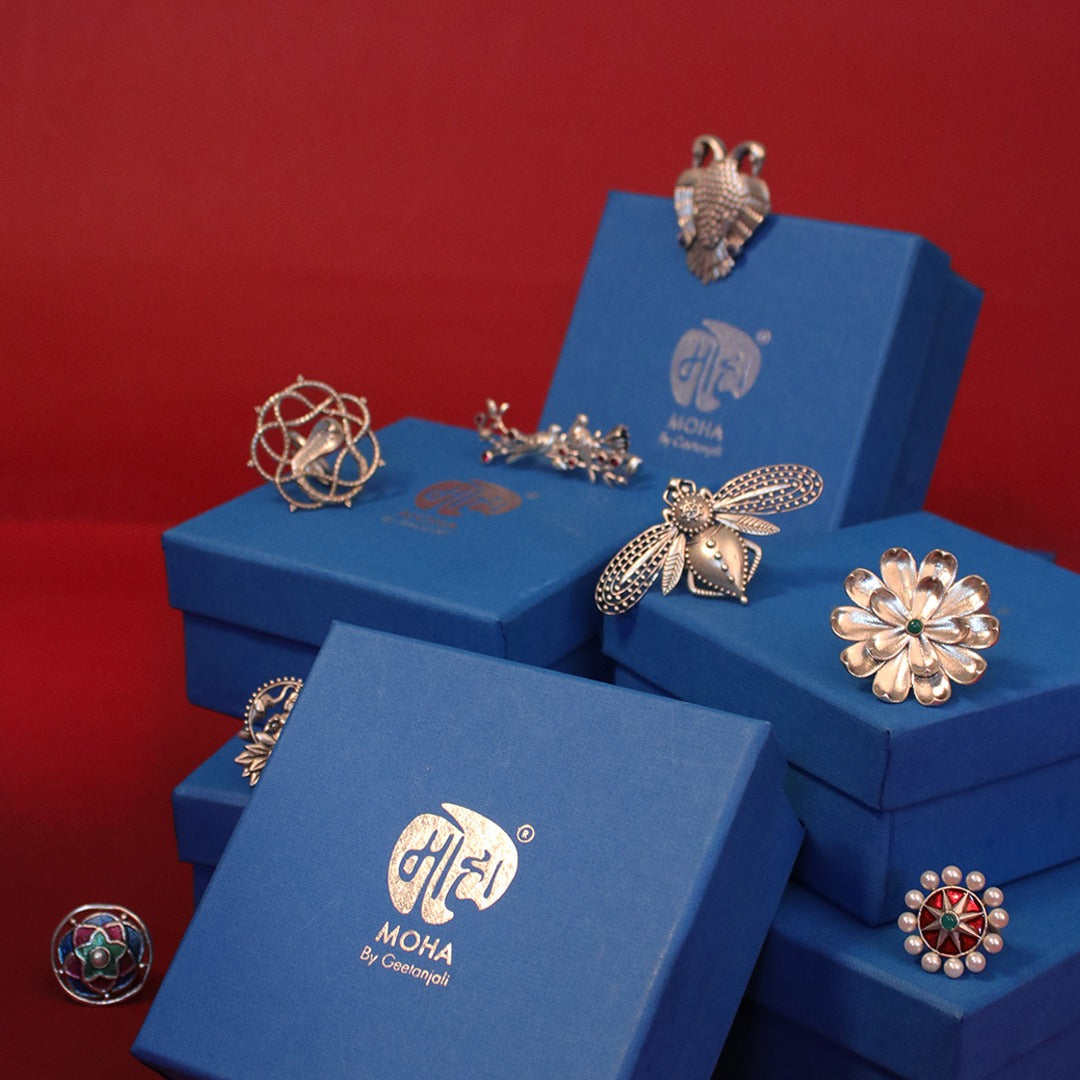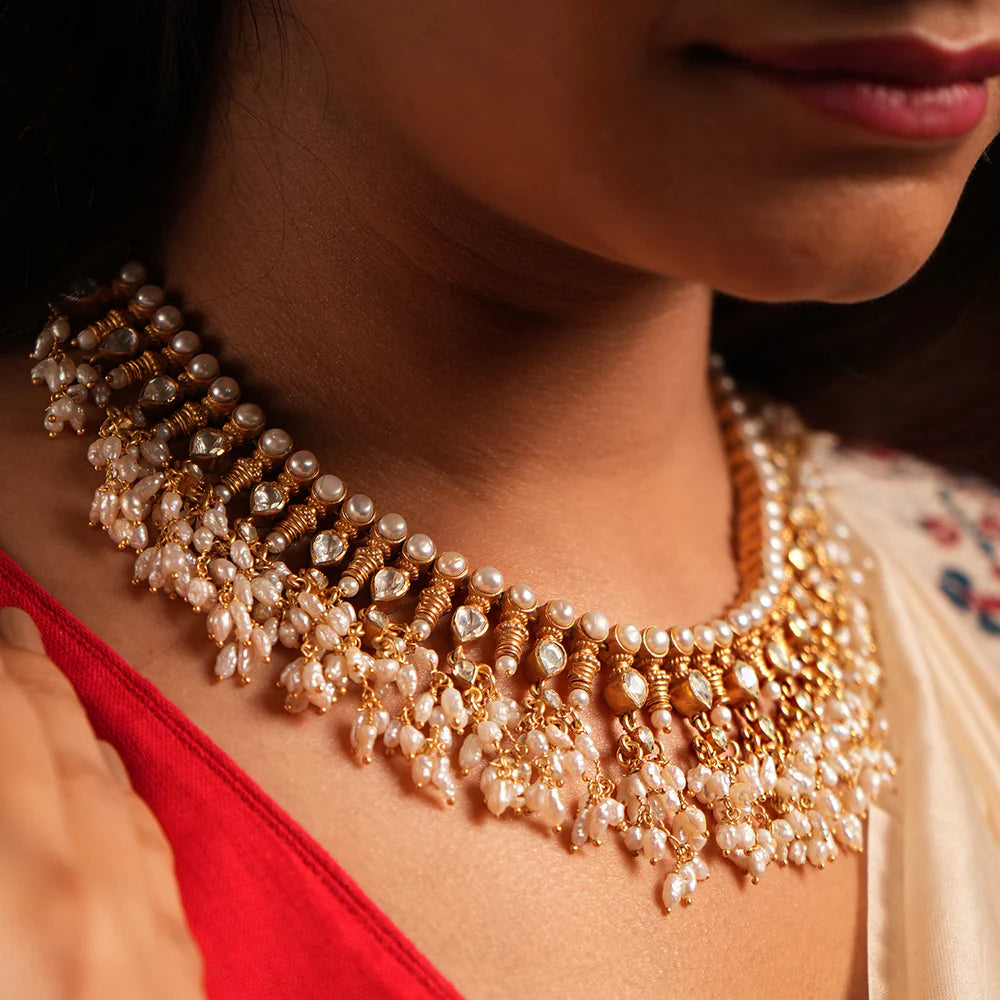Introduction to Gold Plating in Jewellery
Gold plating is a popular jewelry technique that involves applying a thin layer of gold to a base metal, such as silver, copper, or brass. This process changes the finishing of jewelry. Gold-plated jewelry has gained popularity due to its striking appearance and affordability compared to pure gold jewelry. Some Gold plated jewelry from Moha Collections are Mudra, Sanchi, Chamba Rumal & Limited Edition.
Benefits of Gold-Plated Jewellery
1. Affordability-One of the most significant advantages of gold-plated jewelry is its extreme cost-effectiveness.It offers the luxurious look of gold at a fraction of the price.
1. Affordability-One of the most significant advantages of gold-plated jewelry is its extreme cost-effectiveness.It offers the luxurious look of gold at a fraction of the price.
2.The Cost-Effective Advantage of Gold- Plated Jewelry. It provides an affordable alternative to so, making it accessible to a wider range of
people.

people.

3. Variety of choice- Gold plating allows for a wide range of designs and styles. Since it is often applied to various base metals, jewelers can experiment with different shapes, textures, and finishes, providing consumers with a diverse selection of fashionable pieces.
4. Hypoallergenic Option
Many gold-plated items are made with hypoallergenic base metals, such as sterling silver, which can
be a safe choice for individuals with sensitive skin. This allows more people to enjoy fashionable
jewelry without the worry of allergic reactions.
5. Fashion Versatility- Indian festive attires and gold-plated jewelry share a deep-rooted connection, often complementing each other to create stunning and culturally significant ensembles. Indian festivals are characterized by vibrant colors, intricate designs, and rich fabrics. Gold-plated jewelry, with its golden hue,
perfectly complements these festive attires.

Types of Gold Plating
Gold Filled
Gold-filled jewelry is a popular alternative to pure gold. It offers a more durable and affordable option while maintaining the aesthetic appeal of gold. Below, we explore the process of gold filling, the thickness of the gold layer, and its durability and value.
The Process of Gold Plating
1. Gold Layer Application: Gold plating involves applying a thin layer of gold onto a base metal using an electrochemical process. Both 18K and 22K gold plating use this technique, but differ in the thickness and purity of the gold layer.
Gold Filled
Gold-filled jewelry is a popular alternative to pure gold. It offers a more durable and affordable option while maintaining the aesthetic appeal of gold. Below, we explore the process of gold filling, the thickness of the gold layer, and its durability and value.
The Process of Gold Plating
1. Gold Layer Application: Gold plating involves applying a thin layer of gold onto a base metal using an electrochemical process. Both 18K and 22K gold plating use this technique, but differ in the thickness and purity of the gold layer.
2. 18K Gold Plating: Contains 75% pure gold and 25% other metals. It offers good durability and a bright golden color. Commonly used for jewelry and other decorative items.
3. 22K Gold Plating: Contains 91.67% pure gold and 8.33% other metals. Provides a more intense golden color but is less durable. Often used for high-end jewelry and luxury items. The thickness of the gold layer determines its longevity. Thicker layers are typically found in higher-quality plating.
4. Final Finishing: After the gold has been bonded, the piece may be polished or
finished to achieve the desired look. This can include buffing, plating with additional layers, or applying protective coatings. E-coating provides a consistent and uniform coating, eliminating the risk of missed spots or uneven thickness. E-coating produces a smooth, glossy finish that enhances the aesthetic appeal of the product. The automated process is highly efficient, allowing for high-volume production. This process creates a highly protective barrier that shields the metal.
5.E-Coating and Gold Plating Together: To maintain the durability of gold-plated
jewelry, some manufacturers combine gold plating with an e-coating layer. This
provides additional protection against wear, tarnish, and corrosion, extending the
life of the gold plating.
6.Thickness of the Gold Layer
The thickness of the gold layer in gold-filled jewelry is significant and is one of its defining characteristics. Gold-filled items typically contain a minimum of 1/20th (5%) of the total weight in gold. Some key points about the thickness include:
Standard Thickness: Most gold-filled pieces have a gold layer that is at least 50 to 100 times thicker than that of standard gold plating, which usually only has a thin layer of gold.
7. The Electroplating Process
Electroplating is a method that employs an electric current to reduce dissolved
metals, allowing them to form a coherent metal coating on a substrate. Here is a step-by-step overview of how the process works:
1. Preparation of the Substrate: The item to be plated (usually made of metal) is thoroughly cleaned to remove any dirt, grease, or oxidation.
2. Plating: As the electric current flows, gold ions migrate to the negatively charged substrate and deposit onto its surface, forming a thin layer of gold. The thickness of this layer can be controlled by adjusting the current density, the duration of plating,and the concentration of gold ions in the solution.
3. Post-Plating Treatment: After reaching the desired thickness, the plated object is removed, rinsed, and sometimes subjected to further treatments, such as polishing or sealing, to enhance the finish and durability of the gold layer.

How to Take Care of Gold Plating
Proper care can significantly extend the life and appearance of gold-plated items.
Here are some tips:
1. Store Properly
Use Soft Pouches: Store gold-plated items in soft cloth pouches, zip-lock pouches,or boxes to prevent scratching.
Separate Storage: Keep them separate from other jewelry to avoid friction that can wear down the plating.
2. Avoid Exposure to Chemicals
Remove Jewelry Before Cleaning: Take off your gold-plated jewelry before using cleaning products, perfumes, or lotions, as chemicals can tarnish the product.
Avoid Chlorine: Keep your items away from chlorinated water (like pools) as it can cause discoloration.
3. Limit Wear Time
Rotate Your Jewellery: If possible, rotate your pieces to minimize wear on any single item.



